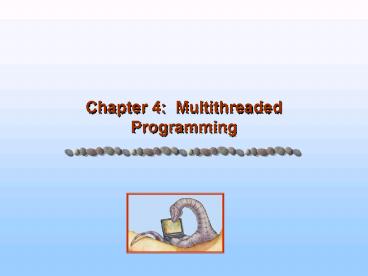Chapter 4: Multithreaded Programming - PowerPoint PPT Presentation
1 / 31
Title:
Chapter 4: Multithreaded Programming
Description:
Process will block if a thread with a blocking system call ... HP-UX. Tru64 UNIX. Solaris 8 and earlier. 4.15. Silberschatz, Galvin and Gagne 2005 ... – PowerPoint PPT presentation
Number of Views:43
Avg rating:3.0/5.0
Title: Chapter 4: Multithreaded Programming
1
Chapter 4 Multithreaded Programming
2
Chapter 4 Multithreaded Programming
- Overview
- Multithreading Models
- Thread Libraries
- Threading Issues
- Operating-System Examples
3
Single and Multithreaded Processes
4
Benefits
- Responsiveness
- Resource Sharing
- Economy
- Utilization of MP Architectures
5
User Threads
- Thread management done by user-level threads
library - Three primary thread libraries
- POSIX Pthreads
- Win32 threads
- Java threads
6
Kernel Threads
- Supported by the Kernel
- Examples
- Windows XP/2000
- Solaris
- Linux
- Tru64 UNIX
- Mac OS X
7
Multithreading Models
- Many-to-One
- One-to-One
- Many-to-Many
8
Many-to-One
- Many user-level threads mapped to single kernel
thread - Examples
- Solaris Green Threads
- GNU Portable Threads
- Advantage
- Management in user space and efficient
- Drawback
- Process will block if a thread with a blocking
system call - Only one thread can access the kernel at a time
and unable to run in parallel on multiprocessors
9
Many-to-One Model
10
One-to-One
- Each user-level thread maps to kernel thread
- Examples
- Windows NT/XP/2000
- Linux
- Solaris 9 and later
- Advantage
- Allow a thread to make a blocking system call
- Allow multiple threads to run in parallel on
multiprocessors - Drawback
- Overhead for creating kernel threads
11
One-to-one Model
12
Many-to-Many Model
- Allows many user level threads to be mapped to
many kernel threads - Allows the operating system to create a
sufficient number of kernel threads - Solaris prior to version 9
- Windows NT/2000 with the ThreadFiber package
- Compromising the above two models
- Many-to-one
- can create as many as user wishes
- One-to-one
- can get rue concurrency (with overhead)
- Many-to-many
- as many as user wishes, run in parallel on a
multiprocessor, without suffering blocking system
call
13
Many-to-Many Model
14
Two-level Model
- Similar to MM, except that it allows a user
thread to be bound to kernel thread - Examples
- IRIX
- HP-UX
- Tru64 UNIX
- Solaris 8 and earlier
15
Two-level Model
16
Threading Issues
- Semantics of fork() and exec() system calls
- Thread cancellation
- Signal handling
- Thread pools
- Thread specific data
- Scheduler activations
17
Semantics of fork() and exec()
- Does fork() duplicate only the calling thread or
all threads? - depends on the application semantics
- if a thread exec(), the entire process space will
be destroyed
18
Thread Cancellation
- Terminating a thread before it has finished
- Two general approaches
- Asynchronous cancellation terminates the target
thread immediately - Deferred cancellation allows the target thread to
periodically check if it should be cancelled
19
Signal Handling
- Signals are used in UNIX systems to notify a
process that a particular event has occurred - A signal handler is used to process signals
- Signal is generated by particular event
- Signal is delivered to a process
- Signal is handled
- Options
- Deliver the signal to the thread to which the
signal applies - Deliver the signal to every thread in the process
- Deliver the signal to certain threads in the
process - Assign a specific thread to receive all signals
for the process - Pthread
- kill(aid_t aid, int signal)
- pthread_kill(pthread_t tid, int signal)
20
Thread Pools
- Create a number of threads in a pool where they
await work - Advantages
- Usually slightly faster to service a request with
an existing thread than create a new thread - Allows the number of threads in the
application(s) to be bound to the size of the pool
21
Thread Specific Data
- Allows each thread to have its own copy of data
- Useful when you do not have control over the
thread creation process (i.e., when using a
thread pool)
22
Scheduler Activations
- Both MM and Two-level models require
communication to maintain the appropriate number
of kernel threads allocated to the application - Scheduler activations provide upcalls - a
communication mechanism from the kernel to the
thread library - This communication allows an application to
maintain the correct number kernel threads
23
Lightweight process (LWP)
24
Operating-system Example
- Explore how threads are implemented in Windows XP
and Linux systems.
25
Windows XP Threads
- Implements the one-to-one mapping (for
many-to-many use fiber library) - Each thread contains
- A thread id
- Register set
- Separate user and kernel stacks
- Private data storage area
- The register set, stacks, and private storage
area are known as the context of the threads - The primary data structures of a thread include
- ETHREAD (executive thread block)
- KTHREAD (kernel thread block)
- TEB (thread environment block)
26
Data Structures of a Windows XP thread
27
Linux Threads
- Linux refers to them as tasks rather than threads
- Thread creation is done through clone() system
call - clone() allows a child task to share the address
space of the parent task (process)
28
flags in the system call clone()
- If all flags used, kernel thread mentioned here
- 2. If no flags used, same as fork()
29
Java Threads
- Java threads are managed by the JVM
- Java threads may be created by
- Extending Thread class
- Implementing the Runnable interface
30
Java Thread States
31
End of Chapter 4































